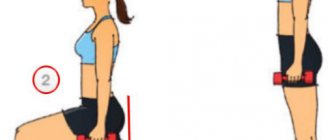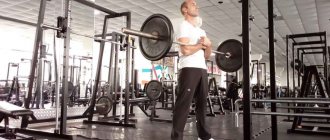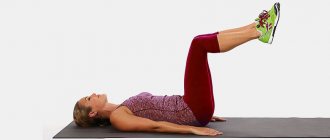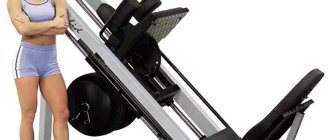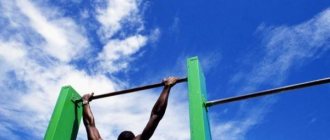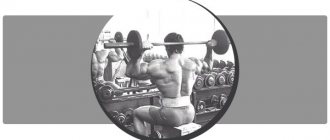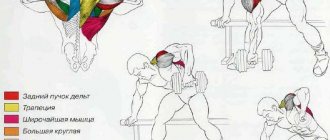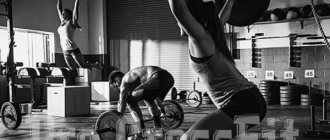Home / Exercises for muscle development / Cross lunges
In the article we’ll talk about cross lunges, also known as diagonal lunges, or curtsy lunges =)
This exercise is more relevant for girls/women because it REALLY works the gluteal muscles very well. In general, any lunges are a very powerful exercise for the buttocks. I recommend saying so.
In addition to the gluteal muscles, the exercise works:
- quadriceps (front thigh)
- hamstrings (back of the thigh)
- the inner thigh (this is a very aesthetically important area of the legs for girls/women, and as a rule, this area is problematic for most, well, flabby, hanging, jelly, etc.).
What does the exercise do?
Cross or oblique lunges are most useful for girls, since working the buttocks is often one of the main goals of women's training. They are often used by athletes participating in fitness bikini competitions to give the lower body ideal proportions.
Cross-legged lunges or curtsey squats.
To perform this exercise correctly, you must have sufficient flexibility in your joints. By using an unusual range of motion that allows us to best work the target muscles, we somewhat compromise the natural position of the knees and ankles. For the same reason, cross lunges use less weight than classic lunges.
The muscle work during the exercise is as follows:
- The gluteus maximus and quadriceps muscles take on the bulk of the load.
- The biceps femoris, semitendinosus and semimembranosus muscles are additionally included.
- The abs and back stabilize the position of the body.
When performing cross lunges with the leg abducted to the side, you can additionally load the gluteus medius muscles. This will be discussed in more detail when considering variations of the exercise.
Contraindications to performing the exercise are any problems with the knee joints or spine.
What muscles work
A fairly large group of muscles is involved in maintaining balance and distributing the load:
- Gluteus maximus and gluteus medius muscles. They bear the maximum load associated with the functioning of the hip joint. When performing this exercise, these muscles increase significantly in length.
- Quadriceps. The muscles of the front of the thigh are actively involved in the work of the knees.
- Biceps femoris muscles. They run along the entire back of the thigh, help keep the back straight, and also partially participate in the functioning of the joints.
- Iliopsoas group. This part of the muscles is responsible for the movement of straight legs, their movement to the sides, and regulate the functioning of the hip joints.
When analyzing which muscles work when performing reverse lunges, it is worth understanding that the use of weights will increase their list. For example, using dumbbells forces the shoulders, radialis, deltoids and biceps to work.
Simple curtsy
Having understood the meaning of the word “curtsy,” it is worth saying that even a modern girl should be able to do it. After all, who knows, maybe someone will one day be able to get an appointment with the Queen of England? And there they still practice this form of greeting. So, it’s best to start learning with a simple curtsy, which is not so difficult to perform. To do this you need to do a few fairly simple manipulations.
- Head. You need to tilt her a little, first nod and keep her in this position during the entire curtsy.
- Skirt. If it is curvy, you need to carefully take it with your thumb and forefinger (the little finger is elegantly set aside), lift it a little and move it to the side. If the skirt is narrow, the arms are simply lowered to the sides of the body.
- Legs. The right leg is slightly extended and placed behind the left, most of the weight should go to the front leg.
- Knees. Next, you need to bend your legs at the knees, doing a slight squat. At the same time, the knees do not look forward, but to the sides, and the back must be straight.
- After all this, you need to gracefully return to your normal position. At the same time, the girl’s body should not sway, her arms should fall along her body, her head should rise proudly.
Leg workout for girls
Lower body exercise is just as important for women as upper body exercise is for men. The leg workout program described below, when performed correctly, can accomplish two tasks at once: burning fat and strengthening muscles. So let's begin.
Workout for hips and buttocks
In terms of complexity, this exercise is not the most difficult, but quite effective.
How to do it:
- Take a gymnastic pole or body bar and stand straight on your toes, shoulder-length
- Hold the bodybar with your hands so that your arms are parallel to the floor
- Start squatting smoothly until your thighs are parallel to the floor.
- Rise up slowly, straightening your legs. Keep your back straight.
- Perform 2 sets of 20 reps
Workout the glutes, quadriceps (front of the thigh) and shoulders
A complex exercise in general aimed at developing the legs, but the anterior deltoid muscles (shoulders) are also involved by raising the arms.
How to do it:
- Take a hard box or step platform (height 50 cm required)
- Stand on the step platform with your left foot, holding dumbbells in your hands
- Begin bending your left leg until your right leg touches the floor
- Push off the floor with your right leg until your left leg is fully extended.
- Perform 15 repetitions for each leg
Hip training (curtsey exercise)
At first glance, this is a simple exercise, but in reality it is quite complex. The exercise is better explained by the illustration above, but I'll still try in words.
How to do it:
- Stand straight with your feet together. Ball in hands at chest level
- Start lunging with your left foot to the right side (behind your right leg)
- Without touching the floor with your left foot (about 20 cm remains), return to the starting position
- Having reached the starting position standing, continue moving your left leg to the side until it is parallel to the floor
- Lunge behind your right leg again
- Perform 15 repetitions for each leg
Butt workout
A variation of one of the most popular exercises for the gluteal muscles is pelvic lifts from a lying position.
How to do it:
- Lie on your back. Arms extended at sides.
- Place your right heel on the ball (precisely a ball, this way the leg muscles are more tense, maintaining balance)
- Raise your pelvis while simultaneously raising your left leg to a vertical position (in the upper position of the pelvis, the buttocks are maximally tense)
- Smoothly return to the starting position, lightly touching the floor with your buttocks
- Repeat lifting the pelvis and legs.
- Perform 2 sets of 25 reps for each leg
Hip flexor workout (rope squats)
An original but powerful exercise that can be performed anywhere, both in the gym and at home.
How to do it:
- Attach a rope or rope at chest level (rope 1.5 meters long)
- Stand shoulder-width apart and grab the free end of the rope
- Rise up onto your toes and lean back, holding onto the rope
- From this position, smoothly squat almost to the floor
- Return to a vertical position, remaining on your toes and tense
- Perform 2 sets of 20 reps
This has already become a classic leg exercise for both girls and guys.
How to do it:
- Sit in the machine, pressing tightly against the back. Place your feet on the plate (shoulder-width apart), holding the special handles at the bottom of the machine with your hands.
- Begin to gently squeeze the plate with your feet, removing it from the stops (depending on the model)
- Grab the handles again and gently bend your legs, lowering the platform
- Bend your legs until you reach a 90° angle (do not lift your buttocks off the floor)
- From the bottom position, perform the plate press, straightening your legs
- Perform 3 sets of 13 reps
Remember that when performing any exercise, it is important to follow the technique. This is the only way the muscles will work fully, without the risk of injury.
If you want to safely get a beautiful body, find a competent trainer.
That's all for today. Watch a great video about leg circuit training and see you next time.
Circular leg training for girls
How to dress for fitness
Exercises with a sledgehammer
The best exercises for the pectoral muscles
Strength training for seniors
Incline Barbell Press
Exercises for the trapezius muscle
Types of lunges with dumbbells
Lunges are one of the most common exercises for working the gluteal muscles and hamstrings.
There are many options for execution; athletes do static, Bulgarian, alternating lunges. Basic technical recommendations:
Static lunges:
- We take dumbbells in our hands, palms facing our hips;
- We put our foot forward. The extreme point is reaching an angle of 90 degrees with both knees;
- We return to the IP and repeat the exercise a specified number of times. Try to keep your body straight, do not lean forward. Lifting should be carried out using the muscles of the thigh of the leg, which bears the main load;
Bulgarian lunges
They differ from static ones only in that the second leg is on the bench (toe of the foot). This is a more difficult version of the exercise. The goal is to perform the required number of repetitions so that the angle in the working leg does not exceed 90 degrees and the knee does not go beyond the toe. At the initial stage, it is better to perform Bulgarian lunges with dumbbells with a light weight, this will avoid injuries. The exercise is difficult due to the fact that in addition to the load on one leg, you need to maintain balance. With a lot of weight this is quite difficult;
Alternating lunges and alternating lunges with advancement:
- We do everything the same - we take the IP position, fix the body straight, take dumbbells in our hands, look in front of us;
- We take a step forward with our right foot and squat on it. The extreme point is an angle of 90 degrees;
- We return to IP and take a step forward with our left foot without stopping. You need to walk, alternately squatting on one of your legs. This is the most effective technique for those athletes for whom regular lunges do not allow them to achieve good results.
In all types of lunges with dumbbells, we squat as we inhale, and rise as we exhale. The most common mistake is tilting the body forward. Just as popular is placing the knee behind the foot. This is strictly forbidden, as you reduce the effectiveness of the exercise hundreds of times and risk injury.
5 Key Secrets to Dumbbell Lunges
Lunges with dumbbells are an ideal solution for athletes with spinal injuries. The barbell makes the exercise more stable and comfortable, but not everyone can afford to “put” such a load on their back.
Main secrets:
- Turn the toe of your front foot slightly inward - this will help you maintain your balance;
- You can increase efficiency by using an elevation - place your “working leg” on a platform of 10-20 cm. The buttocks and biceps will be more stretched and loaded;
- The back foot must be on the toe. You should not use it when lifting or squatting. It acts only as a stabilizer; its task is to ensure the stability of the position. The entire load should be directed to the “working” leg;
- Try to rise slowly and smoothly, and to increase the load on the buttocks, do the rise exclusively on the heel. You can control the process quite simply - slightly lift your sock off the ground;
- Never exceed a 90-degree angle or extend your working knee beyond your foot. If you don't follow these rules, you'll be wasting your time and energy.
Lunges with dumbbells are not recommended for people with bad knees. Quite a lot of stress is placed on the joints, and you can injure them even more.
To whom, when and how much
For whom: Static lunges are ideal for both beginners and experienced athletes, but Bulgarian or alternating lunges are for more advanced bodybuilders;
When: The exercise is basic, therefore, it is recommended to perform it at the beginning of training. Don’t forget to pump your calves at the end of the training, calf raises with dumbbells in your hands and standing calf raises to help you;
How much: Classics of the genre - 8-12 repetitions on each leg, 3-4 approaches. The recommended weight of dumbbells at the initial stage is 3-5 kg each.
Lunges with dumbbells will allow you to develop the gluteal muscle and hamstrings, and also work out the quadriceps well.
Masses and relief to you!
Variations and tips
The lunges themselves are a fairly simple movement. There are many ways to diversify them.
- While performing oblique or diagonal lunges in a dynamic manner (returning the supporting leg to the starting position after each squat), try making an additional swing to the side with that leg. This way you will put additional stress on the gluteus medius muscle. This will make your butt workout more comprehensive.
- Place your working foot on a small step. It could be a step platform or something else. Move your supporting leg back in accordance with the movement technique. By performing lunges or curtsy squats in this way, you will stretch your buttock as much as possible, which will make the workout even more effective.
- You can alternate the load by alternately stepping back with your right and then your left foot.
Concluding the review of the exercise, it should be said that movement technique should always be preferred to the magnitude of the load. Train yourself to do the exercise correctly without additional weight. Having brought the movement to automaticity, you can take dumbbells, as the most convenient option, or a barbell.
Performing oblique lunges in combination with other exercises for the legs and buttocks, such as squats, abductions, gluteal bridges, can make your figure harmonious and toned, and your muscles strong and elastic. The most important thing is to train for pleasure, then the results will not be long in coming.
Curtsy
(French révérence -
deep respect, respect
) - a traditional gesture of greeting, the female equivalent of a male bow in Western culture. When performing a curtsy, a woman takes one leg back, touching the floor with the tip of her toe and, bending her knees, performs a half-squat, at the same time tilting her head, looking down. The skirt is usually held lightly with your hands. The dance curtsy is performed in combination with steps and with the foot moving forward on the toe. In the 18th-19th centuries. curtsies were performed not only by women, for example, in A.S. Pushkin’s novel “The Blackamoor of Peter the Great” it is twice said about curtsies performed by men: once to greet the sovereign (Peter I), another time it speaks of the need for three curtsies to greet a young lady.
This type of greeting is usually used in relation to a person of higher social status. In European culture, women traditionally curtsied to aristocrats or royalty. Also, according to dance etiquette, a woman always made a curtsy before starting a dance in response to the gentleman’s bow.
On stage, dancers curtsy at the end of their performance to show gratitude and/or acknowledge the applause of the audience, often performing several curtsies in a row in different directions. Also, at the beginning and end of a ballet class, students traditionally curtsy to the teacher and pianist.
In everyday life, over time, curtsy was replaced by a curtsy: a woman slightly bends her legs at the knees and makes a slight nod. The knixen squat is not as deep, and, unlike a smooth curtsey, it is performed quickly. A student's teacher or a female domestic servant greeted her employer with a knixen.
Nowadays, neither curtsy nor curtsy are practically used in everyday life. However, the tradition of curtseying to members of royal families still persists.
Execution technique
Let's look at cross-legged lunges, or so-called curtsy squats, in more detail.
So, stand up straight, place your feet slightly wider than your shoulders and point your toes slightly apart. Your knees should be pointing in the same direction as your toes. A serious mistake would be to curl the knees during a squat, i.e., if the foot is pointing outward, the knee is turned outward, if inward, then inward.
- Shift your weight to one leg and take a long step back with the other, diagonally towards your supporting leg. As a result, you have one leg in front, the toe of its foot is directed outward, the second leg is behind, crosswise, its toe is directed forward or very slightly inward (the knee is in the same direction).
- Squat down, bending the knee of your working leg so that your thigh is parallel to the floor. The knee does not go beyond the toe, and the weight remains on the heel throughout the entire movement. With the knee of your supporting leg, reach towards the floor behind your working leg, but do not touch it. At the bottom of the squat, you should feel a stretch in the gluteal muscles of your working leg.
- Rise up with your legs straight.
Next, you can either repeat squats without changing the crossed position of your legs, or return to the starting position (feet wider than shoulders) and on the next repetition take a step back with your supporting leg and squat. The second option makes the exercise more dynamic and is recommended if you are training for fat loss.
Traditionally, lunges are performed 15–20 times in each direction in 3–4 approaches. However, you can vary the load depending on your training goals.
Ballet curtsy
I would also like to talk about such a concept as a ballet curtsey. What it is? This is a kind of bow of the girl in front of the guy before they start dancing. Also, a ballet curtsy can be used at the beginning and end of the performance, as a thank you to the musical accompaniment, teacher, etc. The algorithm of actions in this case will be as follows:
- The starting position is the first.
- Next, you need to take a small step to the right with your right foot, while the toe should look exclusively to the side.
- The next point: the weight needs to be transferred to the right leg, which is slightly behind the left.
- Now the weight is transferred to the tips of the toes of the left foot.
- The back is straight, the legs are bent, the knees look exclusively to the sides (and not forward), the arms are in the first position, the head is slightly lowered.
- The position of the legs remains the same, but the arms smoothly move to the fourth position. The head also rises smoothly.
- To completely complete the bow, the same body movements are repeated in the opposite direction.
So, the definition of the concept of “curtsey” is already extremely clear: what it is and how to do it correctly. It is worth mentioning that there are other types of these body movements, for example, a curtsey with a lunge or the “Texas curtsy,” which is relevant for debutantes at a Texas ball. And there are many such nuances, but they need to be studied separately.
Meet your new favorite - the curtsy lunge. This exercise removes the “ears” on the hips and tightens the buttocks. Let's get started?
Today we propose to go back to the origins, or rather, rewind time and find ourselves in the 17th century, when girls curtsied to greet members of royal families. If for them this was considered a mandatory attribute of etiquette, then for you such a bow can be an excellent way to pump up the outer and inner surface of the thighs, as well as tighten the “fifth point”.
- Position A: Stand straight: feet hip-width apart.
- Position B: Stepping back with your right foot, bring it behind your left leg, as if in a curtsey. Go down as low as possible so that the knee of your supporting leg is bent at an angle of 90 degrees. This is 1 repetition.
One leg is pulled back and the tip of the toe touches the floor, the knees are bent, the head is tilted, the gaze is directed downward, and the skirt is held with the hands - perhaps this is the first thing that is taught to dancers, girls born into royal families, and, more recently, ordinary women, who were lucky enough to marry into blue blood. The art of curtsy is as old as the institution of the monarchy itself, and, despite the fact that since the time of the ancient dynasties the technique of bowing in different countries has undergone significant changes, greeting kings with respect still remains a strong tradition.
For a long time, curtsy was considered one of the most beautiful and feminine gestures. It was performed smoothly and sedately - largely due to the fact that previously ladies wore fluffy long dresses, and their body was firmly fixed with a tight corset, which prevented unsightly arches in the back. Modern princesses, duchesses and countesses, however, almost never wear fluffy dresses (let alone corsets) - accordingly, for them the task of bending the knee and not looking like a person who cannot maintain balance becomes even more difficult.
And these are not just words: if you look at photographs of modern royalty, it becomes obvious that in such a delicate issue a lot depends on the degree of “professional training”. Moreover, the fact of being born with a golden spoon in your mouth does not provide any advantages. It is enough, for example, to compare how Princess Beatrice of York curtsies and how the Duchess of Cambridge does it, who, as you know, spends a lot of time on exercise machines.
In general, the standards for performing a curtsey are more or less the same in all monarchies. An exception, perhaps, can only be the Danish Royal House, where there is a tradition of squatting significantly lower than expected (when the knee almost touches the ground), which Crown Princess Mary gracefully demonstrates every time.
Today, by the way, although royals do not refuse curtsies, they are still rapidly moving towards depriving this ritual of the corresponding degree of officialdom. For example, contrary to protocol, many already prefer not to bow their heads down or lower their gaze. On the contrary, if we are talking about members of the same family or about royalty who have known each other for a long time, it is quite acceptable to hug, hold hands, or even give a couple of kisses on both cheeks during a curtsy.
Should the President bow to the King?
Well, and finally, about the order of relationships between real heads of state and representatives of royal families. Naturally, within the framework of one state, the actual power in the person of the prime minister bows to the monarch and members of his family. This is why, for example, Margaret Thatcher and Theresa May had to learn the art of curtsy.
As for the heads of various states, this, as it turns out, is purely a matter of politics and courtesy. According to established custom, presidents, prime ministers and chancellors are not required to bow before monarchs, since in a legal sense they remain the same heads of their countries. Neither Margaret Thatcher nor Theresa May bowed to the Emperor of Japan during visits (though the Baroness was happy to bow to King Juan Carlos of Spain), and German Chancellor Angela Merkel did not curtsy to Elizabeth II. On the other hand, when Her Majesty made a state visit to Germany in 2020, the wife of the country's president, Gerhild Gauck, bowed to the monarch out of politeness (although her husband did not do so).
But perhaps the most controversial reaction at the time was caused by the inconsistent behavior of Barack Obama, who, on a state visit to Great Britain in April 2009, greeted the Queen with a handshake, and, going to Japan six months later, bowed deeply to Emperor Akihito (Michelle does not curtsey became). Then this gesture of their president caused an incredible wave of indignation among the people of the United States, because in fact it looked as if giant America was bowing to tiny Japan. In short, no one appreciated Mr. Obama's courtesy.
Donald Trump, however, did not repeat the mistakes of his predecessor. During his recent visit to Japan, neither he nor his wife Melania bowed to the imperial couple. Which, however, is very different from the behavior of the 45th US President in Saudi Arabia in May, when he, accepting the order from the king, made a barely noticeable curtsey (it was not even a bow) to the monarch. It's funny that during his election campaign, Donald Trump openly called Obama an "amateur" for his habit of bowing to foreign kings. But, apparently, even such an unprincipled person as he cannot always resist the areola emanating from sovereigns.
Cross lunges allow you to effectively work your gluteal muscles. Thanks to the crossed position of the legs, similar in technique to a curtsey, the gluteal muscle receives an excellent stretch in the lower phase of the movement. Performing this exercise with dumbbells, a barbell, or even no weight at all allows you to create rounded, toned buttocks, visually lifting them and separating them from the hamstrings.
